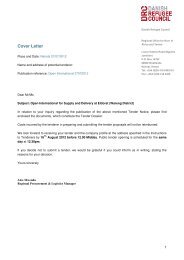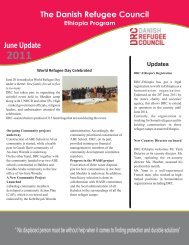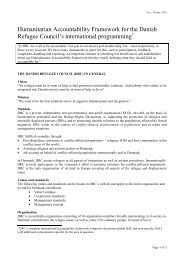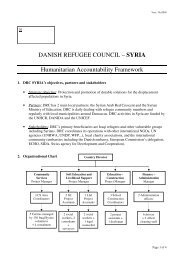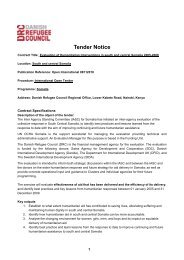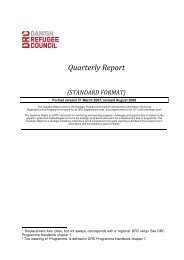Behind the Scenes, Kenya IDP Report - Danish Refugee Council
Behind the Scenes, Kenya IDP Report - Danish Refugee Council
Behind the Scenes, Kenya IDP Report - Danish Refugee Council
You also want an ePaper? Increase the reach of your titles
YUMPU automatically turns print PDFs into web optimized ePapers that Google loves.
Chapter 4: The Role of Civil SocietyIndeed, <strong>the</strong> electoral violence that took place in<strong>Kenya</strong> in 2007/ 2008 highlighted <strong>the</strong> Government’sfailure to respond to <strong>the</strong> protection needs of <strong>IDP</strong>swithin a clear and specific implementation framework.Developing such a framework ra<strong>the</strong>r than introducingamendments to o<strong>the</strong>r sectors appearedto be an efficient way of addressing displacementand developing a specific policy to deal with it. Thesense of urgency also came from <strong>the</strong> perceptionthat <strong>Kenya</strong> needed a policy to prevent <strong>the</strong> recurrenceof violence in following presidential elections,expected at <strong>the</strong> time to take place betweenAugust and December 2012. The advocacy initiativeswere actively led by CSOs (through <strong>the</strong> PW-GID) with some participation from Government.Consequently, while <strong>the</strong> proposal to radically alter<strong>the</strong> legal architecture for dealing with internaldisplacement did not receive opposition from <strong>the</strong>Government, <strong>the</strong> latter remained ra<strong>the</strong>r indifferentand uncommitted to <strong>the</strong> process.The Commission of Inquiry into <strong>the</strong> Post-ElectionViolence had made <strong>the</strong> following diagnosis:From <strong>the</strong> evidence we have ga<strong>the</strong>red so far, <strong>the</strong>reexists sufficient basis for enacting a clear policy andlegal framework for dealing with <strong>IDP</strong>s. […] While<strong>the</strong>re are coordinating organs for dealing with emergencysituations, it is now imperative to put <strong>the</strong>problem of <strong>IDP</strong>s on a sound statutory footing wherelines of authority and responsibilities are assigned.There is no reason why such an enactment can notbe put in place within <strong>the</strong> next four months. 68From <strong>the</strong> assessment carried out by civil societyactors at <strong>the</strong> time, a specific policy and legislationon internal displacement could greatly improve<strong>the</strong> protection of <strong>IDP</strong>s in <strong>Kenya</strong>. This view wasconfirmed by all respondents interviewed for thisstudy.4.2. Policy ChoicesHaving identified <strong>the</strong> issue, civil society actorshad to make choices among various policy options.First <strong>the</strong>y had to choose between developing an<strong>IDP</strong>-specific framework and incorporating protectionmechanisms into already existing frameworks.They <strong>the</strong>n had to agree on <strong>the</strong> standards ofprotection which would have to be incorporatedinto <strong>the</strong> policy. These standards represented variouspolicy options and CSOs even convened forumsto build consensus among stakeholders onpossible frameworks based on internationally recognisedprotection standards. 69During discussions on whe<strong>the</strong>r or not <strong>the</strong>re existedsufficient provisions in existing legislation todeal with displacement, some expressed concernthat having a specific law and policy on <strong>the</strong> protectionof <strong>IDP</strong>s could institutionalise <strong>the</strong> status of<strong>IDP</strong>s, <strong>the</strong>reby making it a permanent problem in<strong>Kenya</strong>, or marginalise <strong>the</strong> issue, <strong>the</strong>reby reducing<strong>the</strong> likelihood of reaching adequate governmentresponse to <strong>the</strong> problem. CSOs managed to deconstructthis misconception by showing that internaldisplacement went beyond <strong>the</strong> 2007/2008post-election violence, and as such <strong>the</strong>re was needto have a sustainable framework to prevent futuredisplacements while making provisions for assistanceand protection. This was accomplishedmainly through sensitisation forums targeting keystakeholders in <strong>the</strong> policymaking process.4.3. Policy FormulationThe <strong>Kenya</strong> scenario became quite interestingwhen it came to policy formulation. While <strong>the</strong>Executive was working on <strong>the</strong> broader policy, <strong>the</strong>Legislature came into <strong>the</strong> picture focusing on legislationthrough an act of Parliament. CSOs immediatelysaw a risk for two parallel processes todevelop and sought to reconcile <strong>the</strong>m by playing abridging role between <strong>the</strong> executive and <strong>the</strong> legislature.They managed, to a great extent, to ensurethat <strong>the</strong> content of <strong>the</strong> resulting legislation remainedcompatible with <strong>the</strong> content of <strong>the</strong> broaderpolicy.From 2007, <strong>the</strong> PWGID had been actively involvedin <strong>the</strong> process of drafting <strong>the</strong> broader policy inpartnership with MoSSP and o<strong>the</strong>r actors. Later,it also partnered with <strong>the</strong> PSC to draft and review<strong>the</strong> content of <strong>the</strong> <strong>IDP</strong> Bill, <strong>the</strong>reby ensuring thatboth <strong>the</strong> Policy and <strong>the</strong> Bill incorporated internationalstandards on <strong>IDP</strong> protection. The process ofdrafting <strong>the</strong> <strong>IDP</strong> Bill brought about many technicalquestions. Key contentions included <strong>the</strong> extent towhich substantive provisions should be written, asopposed to scheduling <strong>the</strong> relevant instruments.This caused tensions within <strong>the</strong> drafting team. In<strong>the</strong> end, a mixture of both drafting methodologieswas achieved as stakeholders lobbied for specificprovisions that did not appear in any of <strong>the</strong> internationalinstruments to be substantively drafted.In terms of content, concessions also had to bemade at every stage. The broader terminology of“arbitrary displacement”, for example, was amendedto cover development projects and projects toprotect <strong>the</strong> environment. While such a provisionwould have provided an additional protection for<strong>IDP</strong>s, some of its aspects are covered under <strong>the</strong>body of law on international humanitarian lawand o<strong>the</strong>r penal laws, so that to some extent such amechanism could be termed unnecessary. Providingfor criminal responsibility was ano<strong>the</strong>r provisionthat was initially contemplated but is coveredby <strong>the</strong> Rome Statute, to which <strong>Kenya</strong> is a signatory,and by <strong>the</strong> International Crimes Act 2008.4.4. Policy AdoptionSince it is <strong>the</strong> prerogative of <strong>the</strong> Government toimplement policies, any advocacy for <strong>the</strong>ir reviewor improvement must ultimately be adopted by<strong>the</strong> Government before being operationalised.The draft <strong>IDP</strong> Policy was approved by <strong>the</strong> Cabinet70and <strong>the</strong> MoSSP is currently working on a sessionalpaper which may be subjected to debate inParliament depending on <strong>the</strong> advice of <strong>the</strong> Attorney-General.In contrast, <strong>the</strong> <strong>IDP</strong> Bill was passedby Parliament and received presidential assent on31 st December 2012.Efforts by <strong>the</strong> Executive to adopt <strong>the</strong> policy havebeen slow. Through <strong>the</strong> PWGID, CSOs have continuedto lobby <strong>the</strong> relevant actors to speed upthis process, including by proposing questions toMoSSP through Parliament in an effort to hold itaccountable to <strong>the</strong> process. The PWGID has alsoplayed a key role in fur<strong>the</strong>ring <strong>the</strong> adoption of <strong>the</strong>draft Bill. The group provided consistent supportto <strong>the</strong> Parliamentary team that was championing<strong>the</strong> legislation through preparation of questionsfor presentation to Parliament, conductingresearch and preparing amendments for <strong>the</strong>improvement of <strong>the</strong> Bill. This included frequentmeetings with <strong>the</strong> MPs to develop strategies onhow to counter any opposition to <strong>the</strong> Bill and incorporationof fur<strong>the</strong>r amendments to <strong>the</strong> Bill forthose that were proposed on <strong>the</strong> floor of <strong>the</strong> House.Generally, as <strong>the</strong> policy development processmoves towards higher levels, non-state actorshave decreasing control over it as legislative development(including eventual approval or rejection)remains within <strong>the</strong> sanctum of Parliament. Therestill remains room, however, to lobby and providelogistical and technical support. For instance, inDecember 2011, participants from a workshop organisedat Pangoni Beach Resort sought to push<strong>the</strong> MoSSP to fast-track <strong>the</strong> process of adopting<strong>the</strong> policy document by cabinet by formulating <strong>the</strong>following question to be presented to Parliamentby an MP (Hon. Ekwe Ethuro, Chair of <strong>the</strong> PSC):(a) Can <strong>the</strong> Minister confirm that <strong>Kenya</strong> lacks anational policy on <strong>the</strong> prevention of internaldisplacement and <strong>the</strong> protection and assistanceto Internally Displaced Persons, despite<strong>the</strong> presence of thousands of <strong>IDP</strong>s and <strong>the</strong> fastapproachingGeneral Elections?(b) Could <strong>the</strong> Minister appraise <strong>the</strong> House on <strong>the</strong>status of approval of <strong>the</strong> said policy as well as<strong>the</strong> status of <strong>IDP</strong>s resettlement?(c) What steps is <strong>the</strong> Minister taking to fast-track<strong>the</strong> formulation, approval and implementationof <strong>the</strong> policy?To <strong>the</strong>se questions, <strong>the</strong> Minister responded:“I wish to confirm that <strong>Kenya</strong> lacks a national policyon <strong>the</strong> prevention of Internally Displaced Persons(<strong>IDP</strong>s). In recognition of this gap, we prepareda Cabinet Memorandum in May, which we circulatedto various stakeholders. Last month, we got aresponse. We hope that in <strong>the</strong> next one or two weeks,it will be able to reach <strong>the</strong> Cabinet level.”18<strong>Behind</strong> <strong>the</strong> <strong>Scenes</strong> – Lessons Learnt from Developing a National Policy Framework on Internal Displacement in <strong>Kenya</strong> 19






